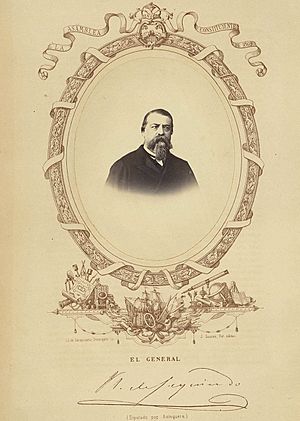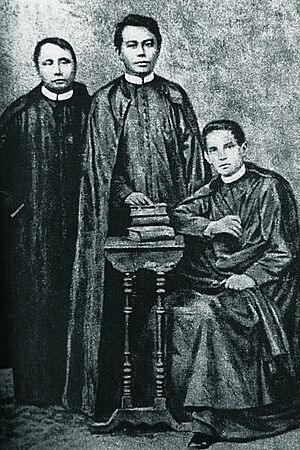Rafael Izquierdo y Gutiérrez facts for kids
Rafael Gerónimo Cayetano Izquierdo y Gutiérrez (born September 30, 1820 – died November 9, 1883) was a Spanish military officer and politician. He served as the Governor-General of the Philippines from April 4, 1871, to January 8, 1873. He was known for his strict "Iron Fist" style of leadership. This was very different from the more relaxed government of the previous governor, Carlos María de la Torre y Navacerrada.
Rafael Izquierdo was Governor-General during the 1872 Cavite mutiny. This event led to the execution of 41 people involved, including the three priests known as Gomburza. Izquierdo also briefly served as Governor-General of Puerto Rico in 1862.
Early Life and Military Career
Rafael Izquierdo was born in Santander, Spain, on September 30, 1820. His parents were Antonio Izquierdo del Monte and Antonia Gutiérrez de la Cámara.
He began his military career as a cadet. By the age of 17, he had already become a captain. He fought in the First Carlist War in Navarre. Later, during the Second Carlist War in Africa, Izquierdo quickly rose through the ranks. He became a lieutenant colonel and then a brigadier general.
In 1861, he was assigned as a military governor in Lugo, Spain. The next year, he became a lieutenant-general in Puerto Rico. He then served as the temporary Governor-General there for a short time. After this, Izquierdo returned to Spain. In 1868, he supported a revolution in Andalusia. He then worked as a deputy for Malaga and Alicante from 1869 to 1871.
Governor-General of the Philippines
Rafael Izquierdo became the Governor-General of the Philippines on April 4, 1871. He took over from General Carlos María de la Torre. During his time, he helped open new steamship and telegraph lines in the country.
However, he also reversed many of the more liberal rules that were in place. He put in harsher laws, which caused tension. For example, soldiers in the Engineering and Artillery Corps, who used to be exempt, now had to pay taxes. They were also required to perform manual labor. These changes led to the 1872 Cavite mutiny. About 200 soldiers revolted and killed their officers.
In response, many people believed to be liberals were accused of being part of the plot. A Spanish military court sentenced three priests, Fathers José Burgos, Mariano Gomez, and Jacinto Zamora (known as GOMBURZA), to death. They were executed by garrote on February 17, 1872.
The uprising also caused delays in rebuilding Malacañan Palace. There was even a plan to move the colonial government back inside the walls of Intramuros for safety. However, this plan did not happen. Izquierdo became ill and stepped down from his position on January 8, 1873.
Rafael Izquierdo spent his last years in Madrid, Spain. He passed away there in 1883.
See also
 In Spanish: Rafael Izquierdo Gutiérrez para niños
In Spanish: Rafael Izquierdo Gutiérrez para niños
- Philippine revolts against Spain
- 1872 Cavite mutiny
- History of the Philippines (1521–1898)
- Freedom of religion in the Philippines



